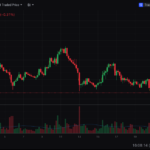In a turbulent start to the week, the global crypto market has been rattled by escalating trade tensions and broader macroeconomic fears. Bitcoin, the world’s largest cryptocurrency, plunged below $75,000 on April 7, reaching levels not seen since late 2024. The drop reflects broader market uncertainty triggered by newly imposed U.S. tariffs and a ripple effect across traditional and digital assets.
According to CoinMarketCap, Bitcoin slumped over 10%, trading around $74,711 at its daily low. Ethereum followed suit, plummeting 15% to $1,537, while altcoins like XRP and Solana recorded double-digit losses.
The backdrop to this crypto selloff is growing global instability. U.S. President Donald Trump’s aggressive tariff measures have sparked fears of a new trade war. Asian markets suffered steep declines—with Japan’s Nikkei 225 down 7.7% and Hong Kong’s Hang Seng index dropping a staggering 13%. Meanwhile, European indices followed with up to 9% declines, and U.S. index futures dipped as much as 6%.
Though markets saw some relief after reports of a potential 90-day pause in tariff implementation, investor sentiment remains fragile. Analysts caution that the volatility may persist unless concrete trade resolutions are reached.
Despite the pullback, on-chain data shows Bitcoin finding technical support around $74K–$71K levels, where major cost-basis clusters exist. According to Glassnode, around 175,000 BTC were last accumulated at these price points, suggesting a possible stabilization zone.
As institutional appetite for Bitcoin remains high—bolstered by ETF inflows and public company allocations—the current correction may offer strategic accumulation opportunities for long-term investors. However, risks tied to macroeconomic uncertainty cannot be overlooked.
This article is for informational purposes only and does not constitute investment advice.







